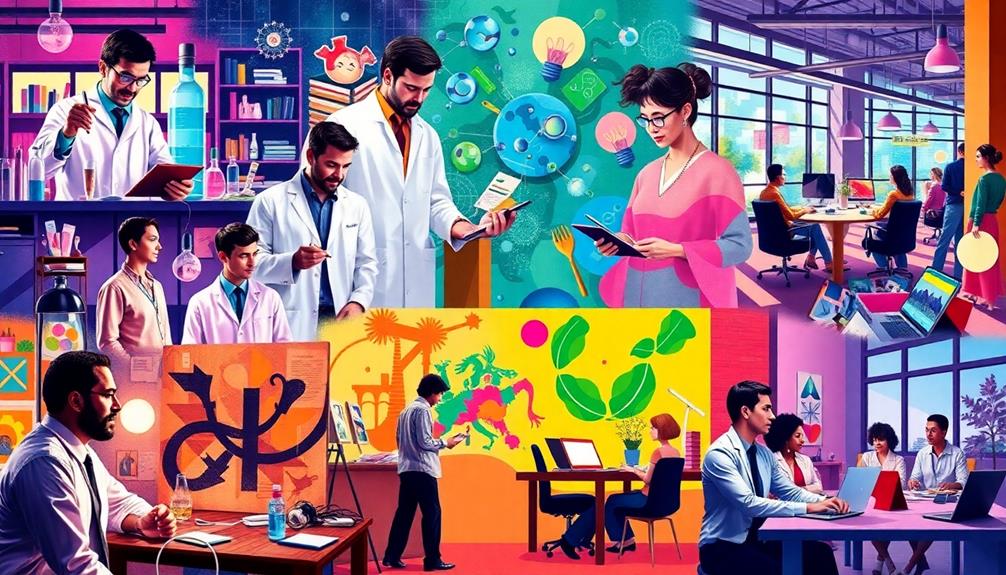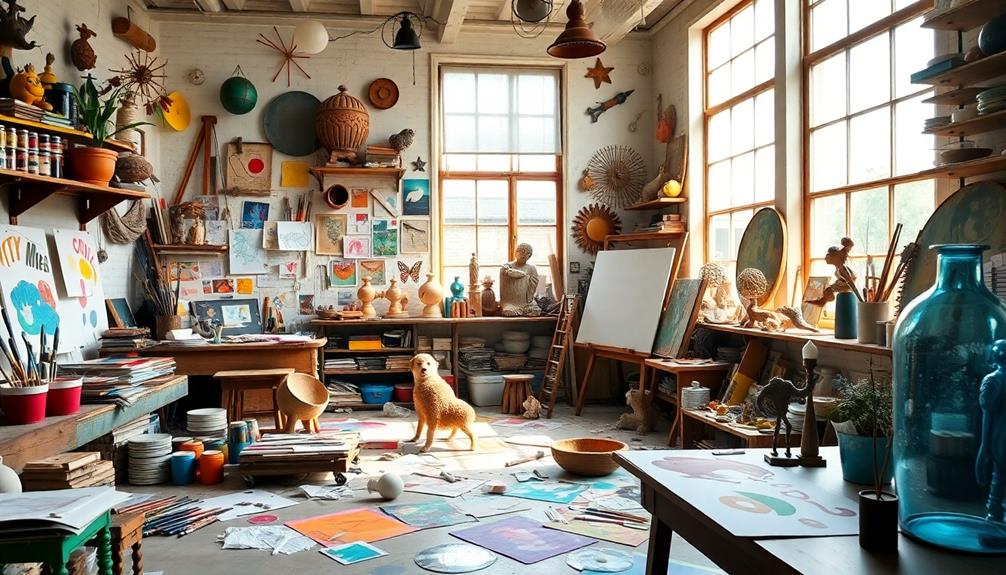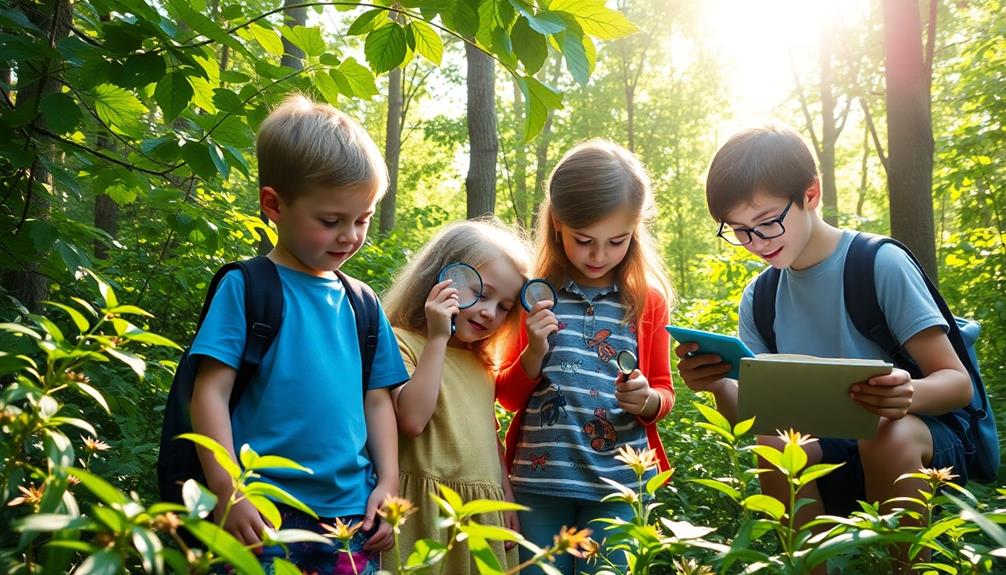In "Curious Minds: Profiles of Innovators and Thinkers," you'll explore how creative individuals leverage their curiosity and resilience to ignite change. Innovators thrive on exploration, turning failures into stepping stones. They harness a strong work ethic and embrace risk, cultivating environments ripe for collaboration and experimentation. Curiosity fuels their creative thinking, leading to innovative solutions and deeper understanding. By engaging diverse perspectives and celebrating achievements, these thinkers shape a dynamic community that thrives on shared insights. You'll find even more inspiring stories and techniques that encourage growth and innovation.
Key Takeaways
- Innovators exhibit insatiable curiosity, driving exploration and challenging conventional thinking to foster new ideas.
- Resilience and persistence are crucial traits, enabling innovators to learn from failures and continue their pursuits.
- Collaboration in dynamic environments encourages diverse perspectives, leading to unexpected breakthroughs in innovation.
- Creative thinking is enhanced by curiosity, which promotes mental flexibility and deep discussions across various disciplines.
- Acknowledging and celebrating creativity is essential for inspiring collective innovation and societal progress.
Characteristics of Innovators

Innovators are often defined by their insatiable curiosity, which drives them to explore new ideas and challenge the status quo. This spirit of inquiry is reflected in various fields, including the arts, where urban themes in contemporary Indian painting serve as a demonstration to the dynamic interplay between tradition and modernity.
As a curious innovator, you possess a strong desire to seek knowledge, always asking questions that push boundaries. This relentless pursuit of understanding allows you to uncover unconventional solutions to complex problems.
Your persistence and resilience set you apart; when faced with setbacks, you view failures as valuable learning opportunities rather than obstacles. Instead of being discouraged, you adapt and refine your approach, continually aiming toward your goals.
A characteristic work ethic also defines you as a curious innovator. You're committed to your vision and put in the diligent effort required to achieve it. You understand that innovation often demands hard work and dedication.
Furthermore, embracing risk is a significant trait of your innovative spirit. You're willing to experiment with new concepts, unafraid of failure, which often leads to groundbreaking discoveries.
Your creative thinking enables you to generate unique ideas that others might overlook. By embodying these characteristics, you truly stand out as a curious innovator, ready to reshape the world around you.
The Role of Curiosity

Curiosity plays a pivotal role in the journey of innovation, acting as a catalyst for creativity and exploration. When you're curious, you foster that childlike thinking essential for generating innovative ideas. It helps you identify gaps that others often overlook, pushing the boundaries of what's possible.
Consider these aspects of curiosity:
- Enhanced Creativity: Curious individuals tend to produce more creative solutions.
- Mental Flexibility: Lifelong curiosity allows you to explore new perspectives across disciplines.
- Rich Discussions: Asking the right questions can lead to deeper understanding and engagement.
- Embracing Humility: Overcoming barriers to curiosity requires a willingness to learn and grow.
- Continuous Learning: Staying curious encourages you to actively seek out knowledge and experiences.
Curiosity not only drives technological advancements but also improves the quality of life. By nurturing this trait, you promote an environment where exploration thrives, and innovation flourishes.
Innovation Spaces and Playgrounds

In innovation spaces, you'll find environments that spark creativity and support risk-taking.
These collaborative areas break down barriers and encourage diverse groups to share ideas freely.
Nurturing Creativity Environments
While many traditional workspaces restrict creative thinking, nurturing creativity environments—like innovation spaces and playgrounds—offer the freedom to explore and experiment.
These settings are vital for sparking new ideas and encouraging collaboration among innovators. By providing diverse tools and resources, they create a culture where risk-taking and experimentation thrive. Incorporating elements from innovative designs, such as multifunctional furniture, can enhance the utility of these spaces, making them even more conducive to creativity.
Consider the benefits of innovation spaces:
- Supportive atmosphere: They foster an environment where you can freely share and develop new ideas.
- Cross-pollination of concepts: Mixing different disciplines can lead to unexpected breakthroughs.
- Encouragement of play: Incorporating playfulness into learning nurtures curiosity and creativity.
- Trial and error mindset: Embracing failures as learning opportunities is essential for innovation.
- Access to resources: Well-equipped spaces help you experiment without limitations.
Research shows that these nurturing environments greatly enhance problem-solving skills and lead to innovative outcomes.
By integrating curiosity and play into your creative process, you'll find yourself more open to new ideas, ultimately driving your projects to success.
Importance of Collaboration Spaces
Collaboration spaces, often referred to as innovation playgrounds, serve as dynamic hubs where creativity flourishes and ideas thrive. These environments are specifically designed to foster creativity and risk-taking, encouraging you to explore and collaborate with others.
Whether it's a physical lab, workshop, or an online platform, these spaces break down silos and facilitate the exchange of ideas, leading to new perspectives. With the rise of AI in education, innovation playgrounds can also incorporate advanced technologies to enhance the learning experience and collaboration among participants.
By integrating diverse tools and resources, innovation playgrounds create an atmosphere that stimulates your imagination and unconventional thinking. Research shows that these collaborative spaces have a positive impact on innovation, greatly enhancing the potential for breakthroughs.
When you work alongside others, sharing unique insights and experiences, you tap into a collective intelligence that drives creativity forward.
Moreover, effective innovation spaces support not only your individual creativity but also cultivate a culture of continuous learning and experimentation. This culture is essential for long-term progress and success in any field.
Embracing collaboration spaces will empower you to think differently, work together, and ultimately, bring about transformative ideas that can change the world.
Techniques to Foster Curiosity

Curiosity thrives when you actively engage with the world around you. To nurture this essential trait, you can adopt several techniques that encourage exploration and innovation.
Here are some effective strategies for you to contemplate:
- Ask Open-Ended Questions: Regularly pose questions that require more than a yes or no answer, promoting deeper discussions and understanding.
- Explore Diverse Hobbies: Engaging in various activities broadens your perspective, stimulating your curiosity and innovative thinking.
- Maintain a Journal: Reflective writing enhances self-awareness, encouraging continuous questioning and exploration of ideas.
- Break Your Routine: Embrace unexpected events and experiences to introduce novelty into your life, fueling your imaginative thinking.
- Seek Diverse Feedback: Learning from different sources not only enhances your knowledge but also encourages you to explore unfamiliar concepts.
Collaboration and Community Impact

Engaging with others amplifies the creative process, turning individual ideas into collective innovations. Collaboration among young innovators serves as a driving force, fostering an environment where unique perspectives can merge to create groundbreaking solutions. When you share your thoughts and experiences, you invite a wealth of creativity that enhances the quality of innovation.
Community engagement initiatives, like workshops and mentorship programs, cultivate supportive spaces for aspiring innovators. These environments enable participants to develop their skills and gain confidence in their abilities. Celebrating the achievements of innovators not only recognizes individual successes but also inspires others in the community to commence their creative journeys.
Integrating diverse voices in collaborative projects enriches problem-solving, allowing for more holistic approaches. Such diversity in thought leads to effective solutions that mightn't have emerged in isolation.
Plus, when you engage in collaborative efforts, you establish lasting relationships, creating networks that facilitate ongoing support and resource sharing.
Ultimately, collaboration and community impact are intertwined, driving innovation and inspiring a collective pursuit of creativity. By participating in these interactions, you contribute to a thriving ecosystem of innovators ready to tackle the challenges of tomorrow.
Understanding Creativity and Recognition

Creativity is often seen as an elusive quality, but it plays an essential role in driving innovation and progress. Recognizing and nurturing creativity can lead to innovative solutions that address the challenges in education and society.
Various organizations highlight the importance of this recognition:
- The National Association for Gifted Children awards individuals who contribute outstandingly to creativity.
- The Berlyne Award from the American Psychological Association emphasizes significant achievements in creative research.
- The Torrance Award from the American Creativity Association honors innovative thinkers, fostering the exploration of creative excellence.
Research shows both genders possess unique creative strengths, influenced more by social and cultural factors than by inherent superiority.
Studies suggest that moderate procrastination might enhance creativity, indicating that time management can impact your innovative output.
Frequently Asked Questions
What Are the 5 Discovery Skills of Innovators?
To understand the five discovery skills of innovators, you'll want to focus on associating, questioning, observing, experimenting, and networking.
By associating, you connect unrelated ideas to find unique solutions. Questioning helps you challenge the status quo, while observing allows you to spot overlooked details.
Experimenting fosters a learning culture through trial-and-error, and networking builds diverse relationships to gain fresh insights.
Together, these skills enable you to innovate and explore new opportunities effectively.
What Is Curiosity as an Innovator?
Curiosity as an innovator means you're always searching for new ideas and solutions. It drives you to ask questions, explore diverse interests, and embrace uncertainty.
When you cultivate curiosity, you open yourself up to opportunities that others might miss. This relentless pursuit of knowledge not only boosts your creativity but also enhances your ability to adapt and innovate.
How Do You Identify Innovators?
To identify innovators, look for individuals who consistently challenge the status quo and embrace new ideas.
They're often curious, enthusiastic to learn, and willing to take risks.
You'll notice their persistence, as they don't shy away from setbacks but rather use them as stepping stones.
Collaboration is key; they thrive in team environments, fostering creativity and driving projects forward.
If someone demonstrates these traits, they're likely an innovator in their field.
Conclusion
In today's fast-paced world, embracing curiosity can lead to groundbreaking innovations. Think about a startup like Airbnb; it sparked from a simple curiosity about how to make space-sharing work. By fostering an environment where questions reign and collaboration thrives, you can ignite your own creative potential. So, plunge into the unknown, explore new ideas, and watch how your curiosity transforms not just your life, but the lives of those around you.








